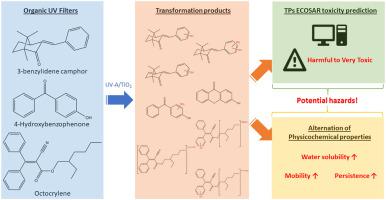Environmental Pollution ( IF 7.6 ) Pub Date : 2021-06-09 , DOI: 10.1016/j.envpol.2021.117551 Japhet Cheuk-Fung Law 1 , Yanran Huang 1 , Chi-Hang Chow 1 , Tsz-Ki Lam 1 , Kelvin Sze-Yin Leung 2

|
Transformation products (TPs) of micropollutants contaminating our water resources have become an emerging issue due to the potential threats they pose to environmental and human health. This study investigated the transformation chemistry, toxicity, physicochemical properties and environmental behavior resulting from photocatalytic transformation of organic UV filters as model micropollutants. 3-Benzylidene camphor (3-BC), 4-hydroxybenzophenone (4-HB) and octocrylene (OC) were effectively degraded by UV-A/TiO2 treatment, with TPs identified and characterized with high resolution mass spectrometry. Nitrated TPs were observed to be formed in the presence of nitrite and nitrate for 3-BC and 4-HB, suggesting that the transformation process could be altered by components in the water matrix. Vibrio fischeri bioluminescence inhibition assay revealed an increase in toxicity of TPs derived from photocatalytic treatment, with quantitative structure-activity relationship model (ECOSAR) predicted an enhanced toxicity of individual TPs' after transformation. Assessment of physicochemical properties and environmental behavior suggested that TPs as compared to parent organic UV filters, may represent even greater hazards due to their increased water solubility, persistence and mobility – in addition to retaining the parent organic UV filter's toxicity. The results provide important information relevant to the potential risks for the selected organic UV filters, and their corresponding transformation products.
中文翻译:

有机紫外线过滤剂及其光催化转化产物的比较理化性质和毒性
由于微污染物对环境和人类健康构成潜在威胁,污染我们水资源的微污染物的转化产物 (TP) 已成为一个新兴问题。本研究调查了有机紫外线过滤剂作为模型微污染物的光催化转化产生的转化化学、毒性、理化性质和环境行为。UV-A/TiO 2处理可有效降解3-亚苄基樟脑(3-BC)、4-羟基二苯甲酮(4-HB)和奥克立林(OC) ,并通过高分辨率质谱鉴定和表征TP。观察到 3-BC 和 4-HB 在亚硝酸盐和硝酸盐存在下会形成硝化 TP,这表明水基质中的成分可以改变转化过程。费氏弧菌生物发光抑制试验揭示了光催化处理产生的 TPs 的毒性增加,定量构效关系模型 (ECOSAR) 预测转化后单个 TPs 的毒性增强。对物理化学特性和环境行为的评估表明,与母体有机紫外线过滤剂相比,TP 可能具有更大的危害,因为它们具有更高的水溶性、持久性和流动性 - 除了保留母体有机紫外线过滤剂的毒性之外。结果提供了与所选有机紫外线过滤剂及其相应转化产物的潜在风险相关的重要信息。











































 京公网安备 11010802027423号
京公网安备 11010802027423号